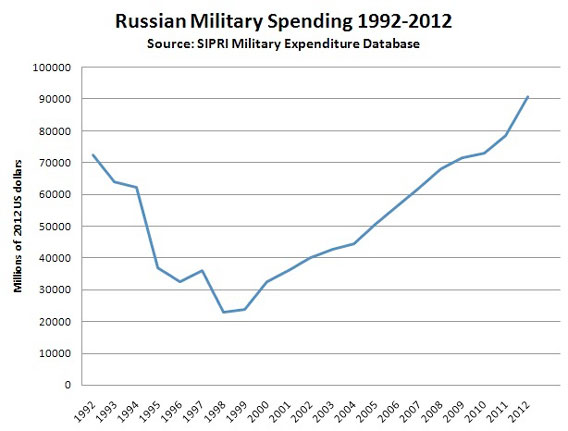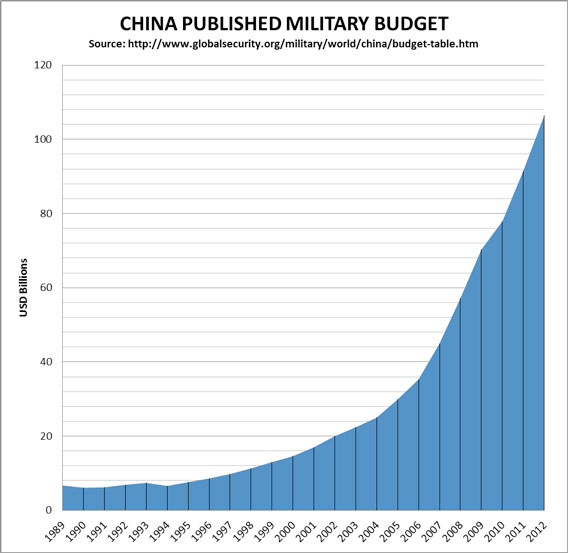The United States still has the largest defense budget in the world, some three times more than China’s and over $500 billion more than Russia’s – and it will have the largest for years to come. The nature of spending in each country, however, gives Russia and China an advantage over the United States in a brewing global arms race.
Related: A Gas Deal With China Could Bail Out 'Mother Russia'
U.S. defense spending went up dramatically during the war on terror, but barring any dramatic strategy shifts, DOD spending is set to go down some $600 billion in the next decade. The chart below illustrates the trend.

Russia and China, however, are in the opposite situation as the U.S.
Both countries are in the middle of dramatic efforts to modernize their militaries. This chart shows trends in Russian military spending.

Over the next six years, Russia is also set to add some $700 billion in additional spending to the budget. So the trend you see ending in 2012 will continue well into the future.
Now, take a look at Chinese defense spending.

Like Russia, Chinese defense spending is trending up as American defense trending is trending down.
Related: Russia's Military Bear Is a Paper Tiger
“Chinese spending in real terms after adjusting for inflation has gone up 10 to 12 percent [annually] for the past decade,” Robert Haddick, a contractor at U.S. Special Operations Command and author of Fire on the Water: China, America, and the Future of the Pacific, told The Fiscal Times. “The Chinese defense budget doubles about every 7 to 8 years in real inflation adjusted terms.”
One could make the argument that even as Russia’s and China’s spending are trending up, their budgets still pale in comparison to that of the United States. But what’s important is not how much money is being spent, but how it’s being spent.
Russia and China are investing in new state-of-the-art equipment. For instance, both countries have sleek new nuclear subs. Russia has a tank that is 14 tons lighter than the American Abrams tank but with equal capabilities. China has made great strides in drone warfare and missile technology to play enforcer in its near neighborhood. Then, there’s cyber warfare, where both China and Russia are at a decided advantage over the United States.
Related: U.S. Plays Catch-Up with China on Cyber Warfare
Meanwhile, the Pentagon is investing in failing weapons programs like the F-35 or in modernizing old weapons systems. This spending reality prompted Defense Secretary Chuck Hagel to overhaul the way the Pentagon develops technology to make it more cost effective while allowing DOD to keep up with overseas rivals.
“While the United States currently has a decisive military and technological edge over any potential adversary, our future superiority is not a given,” Hagel said in early September. “China and Russia have been trying to close the technology gap by pursuing and funding long-term, comprehensive military modernization programs.
They are also developing anti-ship, anti-air, counter-space, cyber, electronic warfare and special operations capabilities that appear designed to counter traditional U.S. military advantages.” Without changes, Haddick warned that the American strategy in Southeast Asia could become obsolete.
“It really puts in increasing jeopardy the U.S. operational concepts that the US has employed,” he said.
One thing the Chinese and Russians don’t do is waste the money they’re allotted. The DOD, on the other hand, is one of the worst abusers of taxpayer dollars.
Top Reads from The Fiscal Times





